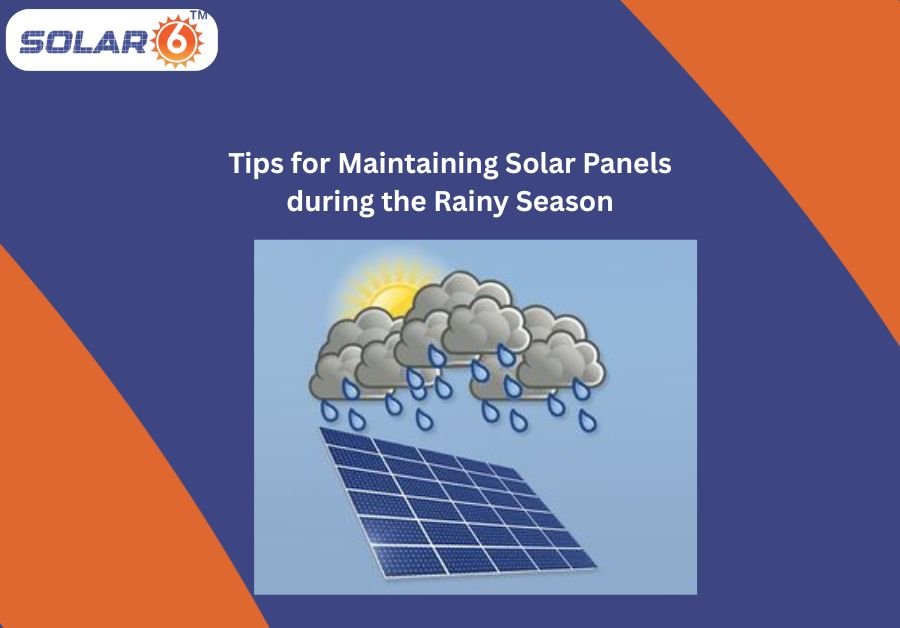Solar power has transformed the way we generate power, mainly for homeowners and businesses investing in rooftop solar systems. However, at the same time, solar panels are designed to be durable and weather-resistant; in the rainy season specific demanding situations to their performance and longevity. Proper maintenance is crucial at some point during monsoons to make certain your solar installation continues at top performance.
In this Article, solar6 explains and provides realistic and powerful suggestions for maintaining your solar panels for the duration of the rainy season, making sure your investment is easy, renewable solar energy continues to repay all year long.
1. Understand How Rain Affects Solar Panels
Rain does not damage solar panels—in reality, it can clean off dust and debris that acquire at some stage in dry months. However, prolonged exposure to moisture, cloud cover, and strong winds can lower the strength technology and doubtlessly result in troubles if the solar panel setup is not well-maintained.
During the monsoon:
- Solar energy output decreases because of reduced daylight.
- Water pooling on panels or near electrical components can cause malfunctions.
- Debris washed by rainwater can gather around panels and drainage areas.
- Corrosion is possible if metallic components aren’t well handled.
Despite those challenges, regular checks and preventive measures can make sure your rooftop solar installation runs smoothly in the rain.
2. Inspect the Solar Panel Installation Before the Rains
Before the rainy season begins, conduct a comprehensive inspection of your entire solar power system.
Key Inspection Areas:
- Panel surface – Check for cracks, dirt, and water stains.
- Mounting structure – Ensure it’s rust-free, secure, and stable.
- Wiring and connectors – Look for signs of wear, corrosion, or loose connections.
- Inverter and batteries – Make sure these are in waterproof enclosures and working properly.
Hiring a professional technician for a pre-monsoon check is highly recommended, especially for larger or older installations.
3. Ensure Proper Drainage Around Panels
Blocked drainage structures can cause rainwater to build up around the solar panels, damaging them over time.
Preventive Steps:
- Clean gutters and downspouts frequently.
- Check roof slopes and water flow paths to make sure there’s no waterlogging.
- Clear leaves, bird nests, and dust from across the panels to keep airflow and drainage.
Good drainage is essential for any rooftop solar machine as it prevents long-term structural damage and protects against dangers.
4. Use Waterproofing for Safety
Waterproofing is one of the most important safety measures during the rainy season.
Focus Areas:
- Electrical junction boxes and inverters must be fully waterproof.
- Cables should be UV- and water-resistant with secure insulation.
- Scaling gaps can be avoided by sealing the spaces between panels and the roof.
Solar panel installation professionals typically use high-grade sealants and enclosures designed to withstand harsh weather. If your system is older, inspect these areas for wear and reseal as needed.
5. Clean Panels Strategically
While rain washes off dirt, it’s no longer usually sufficient, particularly if there are bird droppings, sticky residues, or dust that rain cannot dislodge.
Cleaning Guidelines:
- Use soft brushes or material and a slight cleaning soap solution.
- Avoid abrasive materials or excessively stressed hoses.
- Wait for a dry day or drizzle for safe cleaning.
- If the panels are hard to reach, consider hiring a professional rooftop solar cleaner.
Regular cleaning guarantees you get the maximum possible output from solar energy at some stage in cloudy days of the rainy season.
6. Monitor Energy Output Frequently
The best way to detect problems early is to monitor your system’s solar power generation.
Tips:
- Compare daily energy manufacturing before, during, and after rain.
- Watch for unusual drops in output, which can suggest a malfunction or dirt buildup.
If you notice a sharp decline, it may be time to clean the panels or look into the inverter for troubles resulting from moisture or voltage drops.
7. Protect the Inverter from Water Damage
Your solar power device’s inverter is its basic component. It is also among the elements that are most susceptible to moisture.
Maintenance Suggestions:
- Ensure the inverter is housed in a water-resistant enclosure.
- Place it in a raised, well-ventilated space that doesn’t flood.
- Use surge protectors to protect against lightning strikes or electrical fluctuations.
If your inverter is already a few years old, have a technician look at it earlier than and after the monsoon for signs and symptoms of corrosion or short circuits.
8. Trim Nearby Trees and Branches
Overhanging branches can drop leaves or twigs on the panels and block daylight.
Why It Matters:
- Accumulated natural remember can clog drainage systems.
- Branches may scratch or crack solar panels in heavy winds.
- Falling debris can harm the rooftop or the shape keeping the sun panels.
Regular pruning keeps your solar power system unobstructed and more secure at some point of storms.
9. Use Anti-Rust Treatment on Mounting Structures
The metal systems helping your rooftop solar panels are at risk of rust, especially throughout constant exposure to rain.
Protection Measures:
- Use anti-corrosive paint or coatings.
- Inspect joints and fasteners for early symptoms of rust.
- Replace broken or rusted elements directly to keep away from collapse or misalignment.
A well-maintained structure is essential not only for power generation but also for the long-term integrity of your solar installation.
10. Be Alert to Weather Warnings and Storms
Heavy winds, hailstorms, or lightning can pose a risk to rooftop solar panels during the rainy season.
Safety Steps:
- During extreme weather, temporarily shut off your solar energy system if advised.
- Use lightning arresters and earthing systems to protect from voltage surges.
- Check your panels for physical damage or dust buildup following a storm.
Installing a weather monitoring app or tool can help you prepare your solar system before the worst of the weather hits.
11. Schedule a Post-Rainy Season Inspection
Once the rainy season ends, it’s time to reassess your solar panels.
Inspection Checklist:
- Check for physical damage – Look for water stains, discoloration, or cracks.
- Recheck the inverter and battery – These may have experienced stress due to inconsistent input.
- Test the overall system performance – Ensure energy output has normalized.
A post-monsoon maintenance routine helps ensure your rooftop solar system is ready for high performance during the sunny months ahead.
12. Consider Upgrades or System Enhancements
If you’re in a region with lengthy rainy seasons or frequent storms, it might be time to remember upgrades.
Options to Explore:
- More efficient solar panels that work better in low-light situations.
- Smart monitoring systems for automated overall performance alerts.
- Hybrid systems with batteries to store solar energy at some point of sunshine hours and use it throughout cloudy days.
These improvements ensure your solar power funding stays green and dependable, regardless of the season.
Conclusion
Maintaining solar panels during the rainy season is not just about protecting your investment—it’s far about making sure continuous, clean energy production. With proper inspections, well-timed cleaning, waterproofing, and professional assistance, your rooftop solar system can weather the storms without trouble.
Embracing solar energy is a long-term commitment to sustainability and savings. By giving your solar power system the care it deserves during the monsoon, you’re securing uninterrupted power for years to come. Install Solar6 Solar Panels and brighten your career with us.

